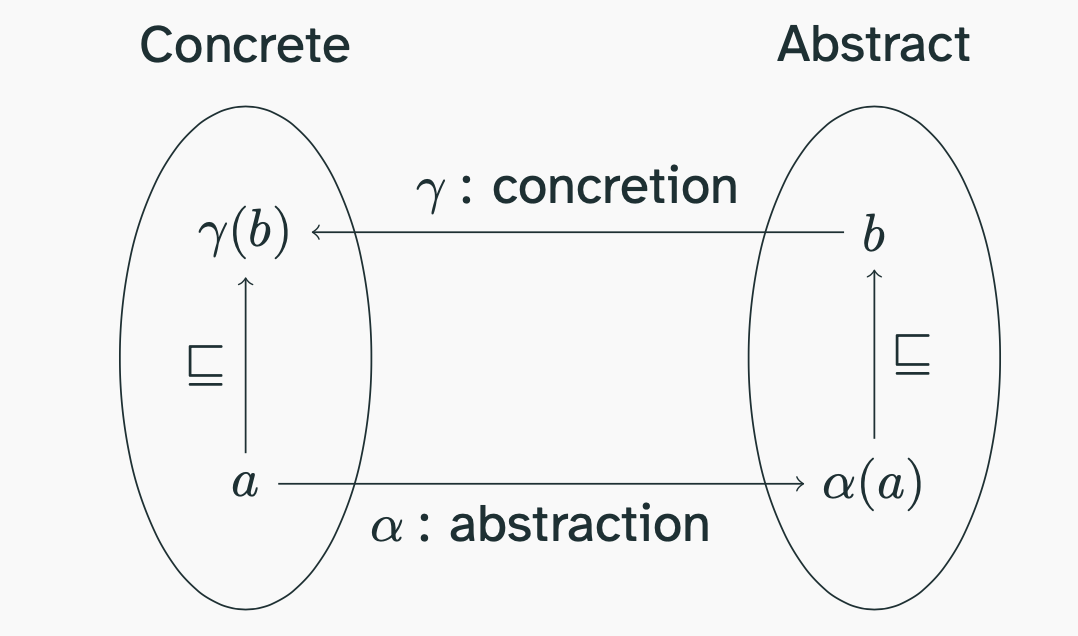Bounded Static Analysis
Everything Everywhere All at Once
Table of Contents
- What is Bounded Static Analysis?
- Abstractions
- Bounded Abstract Interpretation
- Getting Started
Proposal due Wednesday Evening after fall break.
But you can hand it in before.
Questions
Why should we use abstractions when analysing code?
What is the advantage of Galoi connections?
Which cases are the Sign abstraction not able to catch?
At which cases do your static analysis outperform your dynamic?
Feedback
Is this still fun?
What is Bounded Static Analysis? (§1)
In Theory (§1.1)
Breath-first!
May and Must Analyses (§1.2)
Abstractions (§2)
- The Sign Analysis
- Partially Ordered Sets (Posets)
- Lattices
- Galois Connection
- Abstract Operations
The Sign Analysis (§2.1)
is the abstractor
Partially Ordered Sets (Posets) (§2.2)
A partially ordered set
Examples
Integers in both directions
Sets
Signed
Why Partial Orders?
Lattices (§2.3)
Partial orders ,
meet ,
join ,
and has a smallest and biggest element.
Hasse diagrams. (§2.3.1)
A Hasse diagram over the poset . By I, KSmrq, CC BY-SA 3.0 (with edits)
Back to the Sign Abstraction (§2.3.2)
, , and
Galois Connection (§2.4)

(A Galois Connection is a connection between two ordered sets, with a concretion and an abstraction function.)
What are they good for?
A mathematical definition of one-sided information loss. If my abstraction finds a bug, is there a bug in the original domain?
A weak equality.
Laws For Free
Adjunctions and Testing
# Most of the time
parse(pretty(a)) == a
# Always
pretty(parse(pretty(a))) == pretty(a)
# Bonus for all strings s:
parse(pretty(parse(s))) == parse(s)Back to the Sign Analysis (§2.4.1)
Build the Sign Abstraction
@classmethod
def abstract(cls, items : set[int]):
signset = set()
if 0 in items:
signset.add("0")
...
return cls(signset)def __contains__(self, member : int):
if (member == 0 and "0" in self.signs):
return True
... Test your abstaction
from hypothesis import given
from hypothesis.strategies import integers, sets
@given(sets(integers()))
def test_valid_abstraction(xs):
s = SignSet.abstract(xs)
assert all(x in s for x in xs)Abstract Operations (§2.5)
Define the operation
Test your Abstract Operation
@given(sets(integers()), sets(integers()))
def test_sign_adds(xs, ys):
assert (
SignSet.abstract({x + y for x in xs for y in ys})
<= SignSet.abstract(xs) + SignSet.abstract(ys)
)Bounded Abstract Interpretation (§3)
To show , we need to prove:
But we can get away with
The State Abstraction (§3.1)
This is nice because
if , then
The Per-Instruction Abstraction (§3.2)
The Per-Variable Abstraction (§3.3)
Variable Abstractions (§3.4)
Abstractions All The Way Down. (§3.5)
Getting Started (§4)
Abstract Your Interpreter
Emit multiple states.
Start Small, Just One frame.
Emit multiple States
def step(state : AState) -> Iterable[AState | str]
...Do all states at once.
def many_step(state : dict[Pc, AState | str])
-> dict[Pc, AState | str]:
new_state = dict(state)
for k, v in state.items():
for s in step(v):
new_state[s.pc] |= s
return new_stateQuestions
Why should we use abstractions when analysing code?
What is the advantage of Galoi connections?
Which cases are the Sign abstraction not able to catch?
At which cases do your static analysis outperform your dynamic?